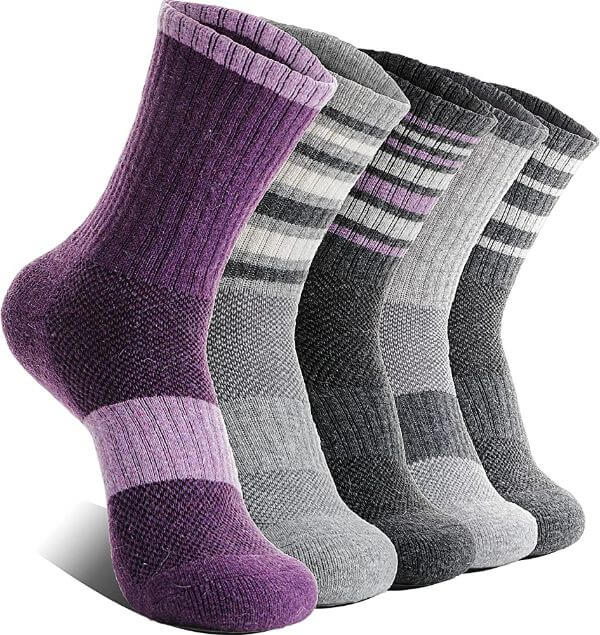When engaging in outdoor activities during the winter months, keeping your feet warm and comfortable is crucial for both enjoyment and safety. The right pair of winter socks can make a significant difference, providing insulation, moisture-wicking properties, and cushioning to protect your feet from the cold, moisture, and potential blisters.
In this blog post, we will explore the key features and considerations for choosing winter socks for popular outdoor activities such as hiking, skiing, and more. Whether you’re an avid adventurer or a casual outdoor enthusiast, these tips will help you find the perfect winter socks to enhance your experience.
Material Matters
Opt for winter socks made from high-quality materials that provide insulation and moisture-wicking properties. Merino wool is a popular choice due to its natural insulation, breathability, and ability to regulate temperature. It is also effective at wicking away moisture, keeping your feet dry and comfortable. Synthetic materials like acrylic and polyester can also offer excellent insulation and moisture management, making them suitable alternatives to wool.
Cushioning and Padding
Consider the level of cushioning and padding required for your specific activity. Hiking socks, for example, should offer extra padding in areas prone to blisters and pressure points, such as the heel, toe, and ball of the foot. Ski socks, on the other hand, may have targeted cushioning in the shin and calf areas for added comfort and protection during skiing or snowboarding. Look for socks with strategically placed cushioning to provide support and reduce fatigue during your chosen outdoor activity.
Compression and Arch Support
For activities that involve extended periods of walking or standing, such as hiking, consider socks with compression features. Compression socks can help improve blood circulation, reduce muscle fatigue, and enhance overall foot support. Additionally, look for socks with built-in arch support to provide stability and alleviate strain on the arches of your feet.
Seamless Design
Seams can cause discomfort and friction, leading to blisters and irritation, particularly during high-impact activities. Opt for winter socks with seamless construction to minimize friction and ensure a smooth, irritation-free fit. Seamless socks are especially important for activities that involve repetitive movements, such as skiing or snowboarding.
Height and Fit
Consider the height of the socks based on your activity and personal preference. Crew or knee-high socks are suitable for hiking and skiing, providing extra coverage and insulation for your lower legs. Ensure that the socks fit snugly but not too tight to avoid restricting blood flow or causing discomfort. Look for socks with reinforced cuffs that stay in place and prevent slippage during vigorous activities.
Moisture-Wicking and Breathability
Winter activities can result in sweaty feet, which can lead to discomfort and potential frostbite. Look for winter socks with moisture-wicking properties that draw moisture away from your feet, keeping them dry and reducing the risk of blisters. Additionally, choose socks with breathable panels or mesh ventilation zones to enhance airflow and prevent overheating.
Multiple Pairs and Layering
Consider having multiple pairs of winter socks for extended outdoor activities. Layering socks can provide additional insulation and moisture-wicking capabilities. Start with a moisture-wicking liner sock close to your skin, followed by a thicker insulating sock on top. This layering technique helps to trap heat and keep your feet dry and warm.
Conclusion
Investing in high-quality winter socks is essential for enjoying outdoor activities during the colder months. When choosing socks for hiking, skiing, or any other outdoor pursuit, prioritize materials that offer insulation and moisture-wicking properties, consider cushioning and padding requirements, and opt for a seamless design for maximum comfort. Ensure a proper fit, consider compression and arch support for added benefits, and prioritize moisture-wicking and breathability to keep your feet dry and comfortable. Remember to choose socks that suit the height and activity, whether it’s crew or knee-high socks for hiking or skiing.
Having multiple pairs of winter socks allows you to layer them for added insulation and moisture management. Consider using a moisture-wicking liner sock as the base layer and a thicker insulating sock on top to provide maximum warmth and comfort.
Lastly, don’t forget to take care of your winter socks to ensure their longevity. Follow the manufacturer’s care instructions, which may include gentle machine washing or hand washing with mild detergent. Avoid using harsh chemicals or bleach that can damage the fabric or affect the performance of the socks. Allow them to air dry thoroughly before storing them in a clean and dry place.
In conclusion, choosing the right winter socks for your outdoor activities is crucial for keeping your feet warm, dry, and comfortable. Consider the materials, cushioning, compression, and fit that suit your specific needs. Opt for moisture-wicking and breathable socks to prevent sweat buildup and prioritize a seamless design to minimize friction and blisters. By investing in high-quality winter socks and following proper care practices, you can enjoy your outdoor adventures to the fullest, even in the coldest of winter conditions.

For over 12 years, I have been testing and reviewing heating technologies that overcome cold weather conditions. In recent years, I have specialized in the heated apparel. I’ve made it my mission to educate people about heated clothing.
